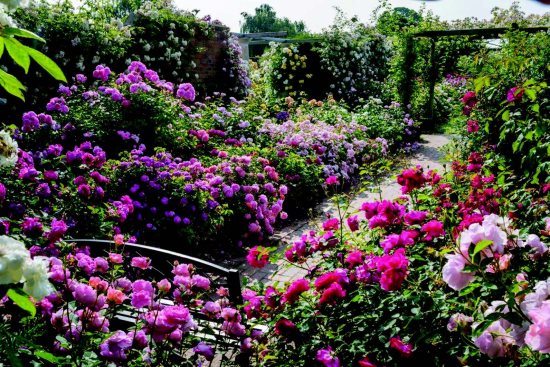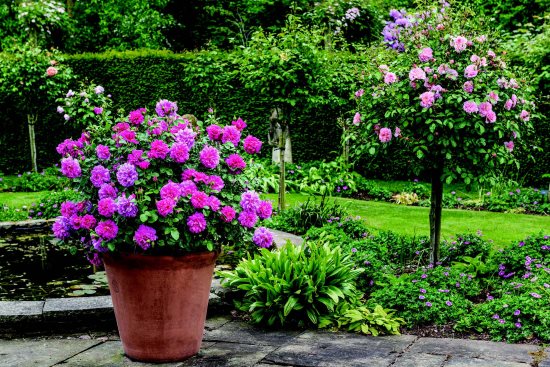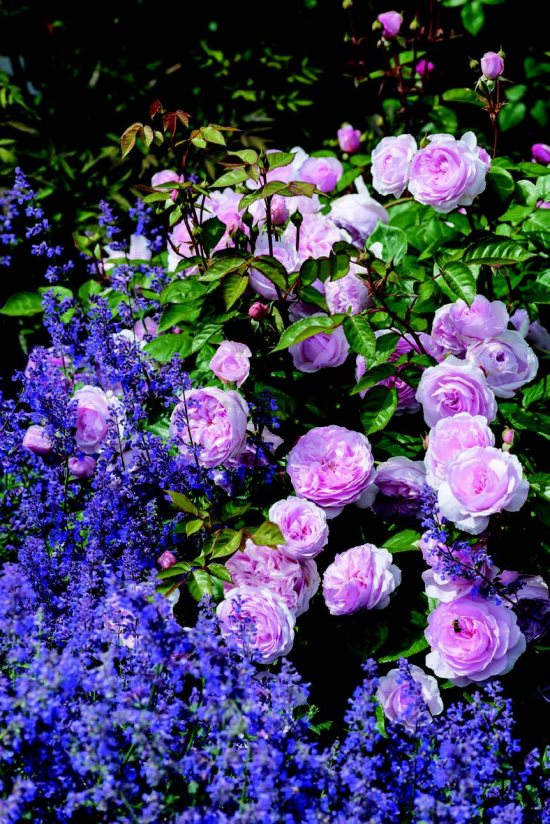|
|
Published January 24th, 2018
|
Cynthia Brian's Gardening Guide for February
|
| Roses are red |
| By Cynthia Brian |
 |
| Mr. Lincoln, the perfect red rose. Photos Cynthia Brian |
"That which we call a rose by any other word would smell as sweet." - William Shakespeare, "Romeo and Juliet"
 Roses are red and pink, salmon, yellow, orange, purple, white, mauve, and are available in a plethora of color combinations and variety choices. Under the thumb of a knowledgeable gardener, roses are one of the easiest plants to grow providing 10 to 11 months of beautiful blossoms. Because of our warmer California weather, my roses are still blooming profusely even though I am in the process of performing my annual winter pruning. (Of course I am gathering the flowers to use in my indoor arrangements and potpourri). Many gardeners shy away from roses assuming they are just to "fussy" and demanding to be sustainable, yet, in my experience, I have always found roses to be the bedrock of my multi-purpose gardens.
Roses are red and pink, salmon, yellow, orange, purple, white, mauve, and are available in a plethora of color combinations and variety choices. Under the thumb of a knowledgeable gardener, roses are one of the easiest plants to grow providing 10 to 11 months of beautiful blossoms. Because of our warmer California weather, my roses are still blooming profusely even though I am in the process of performing my annual winter pruning. (Of course I am gathering the flowers to use in my indoor arrangements and potpourri). Many gardeners shy away from roses assuming they are just to "fussy" and demanding to be sustainable, yet, in my experience, I have always found roses to be the bedrock of my multi-purpose gardens.
 February is the perfect month to plant bare root roses. Whether you are planning to purchase bare root or containerized roses, follow these simple instructions for success.
February is the perfect month to plant bare root roses. Whether you are planning to purchase bare root or containerized roses, follow these simple instructions for success.
 1. Always buy healthy specimens. Choose your plants carefully. A damaged, diseased or dried rose will not recover and may cause problems for your other specimens.
1. Always buy healthy specimens. Choose your plants carefully. A damaged, diseased or dried rose will not recover and may cause problems for your other specimens.
 2. Choose a sunny site where your rose will get at least six hours of sunshine daily.
2. Choose a sunny site where your rose will get at least six hours of sunshine daily.
 3. Enrich the soil with a rich humus organic matter that will allow for good drainage. Roses like acidic soil with a 6.5 pH.
3. Enrich the soil with a rich humus organic matter that will allow for good drainage. Roses like acidic soil with a 6.5 pH.
 4. For container roses, soak the roses for at least half an hour and allow all the water to drain. Bare root roses need their root systems soaked overnight. Do not allow roots to dry out.
4. For container roses, soak the roses for at least half an hour and allow all the water to drain. Bare root roses need their root systems soaked overnight. Do not allow roots to dry out.
 5. Space at least two feet apart to allow for air circulation.
5. Space at least two feet apart to allow for air circulation.
 6. After digging your hole, add compost or rotted material, permitting the bud union to be two to three inches below ground.
6. After digging your hole, add compost or rotted material, permitting the bud union to be two to three inches below ground.
 7. Add three inches of coarse mulch around the roses. The mulch keeps splashing water from spreading fungal disease on the foliage. Blackspot spores may germinate whenever leaves are wet. Fungus must be killed with a fungicide before it enters the leaf tissue. Dust or spray before a rain.
7. Add three inches of coarse mulch around the roses. The mulch keeps splashing water from spreading fungal disease on the foliage. Blackspot spores may germinate whenever leaves are wet. Fungus must be killed with a fungicide before it enters the leaf tissue. Dust or spray before a rain.
 8. Water deeply directly to the soil and keep the soil moist but not soggy. Overhead sprinklers are not recommended.
8. Water deeply directly to the soil and keep the soil moist but not soggy. Overhead sprinklers are not recommended.
 9. Fertilize in the spring. I add a cup of alfalfa pellets to each plant, which I buy at the feed store, combined with diatomaceous earth. Work it well into the soil. Alfalfa supplies nitrogen, calcium, phosphorus, and plenty of other nutrients. Throughout the year, I swirl my used coffee grounds in a quart of water and throw them on the plants. Plus, whenever I eat a banana, the peel flies into the rose garden. The potassium and phosphorus aid in blooming.
9. Fertilize in the spring. I add a cup of alfalfa pellets to each plant, which I buy at the feed store, combined with diatomaceous earth. Work it well into the soil. Alfalfa supplies nitrogen, calcium, phosphorus, and plenty of other nutrients. Throughout the year, I swirl my used coffee grounds in a quart of water and throw them on the plants. Plus, whenever I eat a banana, the peel flies into the rose garden. The potassium and phosphorus aid in blooming.
 10. Encourage beneficial insects to visit your roses to keep diseases away. By mixing lavender, bulbs, and other pollinator attracting plants with your roses, you will have fewer pests to fight.
10. Encourage beneficial insects to visit your roses to keep diseases away. By mixing lavender, bulbs, and other pollinator attracting plants with your roses, you will have fewer pests to fight.
 11. Prune in January or February and cut off faded blooms throughout the year to insure continuous flowering.
11. Prune in January or February and cut off faded blooms throughout the year to insure continuous flowering.
 Although I have a collection of types and varieties of roses in my garden, since meeting senior rosarian of David Austin English Roses, Michael Marriott, English roses have become a favorite staple because of their resistance to disease, their beautiful shapes, varied foliage, and unrivaled fragrance. Marriott will share his expertise about rose care and pruning from 4 to 5 p.m. Jan. 24 on my internationally broadcast radio show, StarStyle(r)-Be the Star You Are!(r). Tune in live or to the archives at
www.voiceamerica.com/episode/104744/david-austin-roses-with-michael-marriott-and-growing-with-the-goddess-gardener
Although I have a collection of types and varieties of roses in my garden, since meeting senior rosarian of David Austin English Roses, Michael Marriott, English roses have become a favorite staple because of their resistance to disease, their beautiful shapes, varied foliage, and unrivaled fragrance. Marriott will share his expertise about rose care and pruning from 4 to 5 p.m. Jan. 24 on my internationally broadcast radio show, StarStyle(r)-Be the Star You Are!(r). Tune in live or to the archives at
www.voiceamerica.com/episode/104744/david-austin-roses-with-michael-marriott-and-growing-with-the-goddess-gardener
Description, links and photos will be at
www.StarStyleRadio.com
.
 These are abbreviated pruning instructions that Marriott shared with me for the best outcomes for your rose garden.
These are abbreviated pruning instructions that Marriott shared with me for the best outcomes for your rose garden.
 Why Prune: It is imperative to prune roses annually to maintain the shape and blooming qualities of the rose. You'll keep your plant healthy and stimulate growth by removing any weak, dead or diseased canes.
Why Prune: It is imperative to prune roses annually to maintain the shape and blooming qualities of the rose. You'll keep your plant healthy and stimulate growth by removing any weak, dead or diseased canes.
 Tools: Loppers, shears, secateurs, saw and gloves. Sterilize tools with alcohol before using and make sure tools are sharp so as not to damage the plant.
Tools: Loppers, shears, secateurs, saw and gloves. Sterilize tools with alcohol before using and make sure tools are sharp so as not to damage the plant.
 When to Prune: Pruning needs to be done during the dormant months of January and February. Later pruning can be detrimental as the plant's energy will be depleted and plants could be susceptible to frost.
When to Prune: Pruning needs to be done during the dormant months of January and February. Later pruning can be detrimental as the plant's energy will be depleted and plants could be susceptible to frost.
 How to Prune: If possible, cut above a bud on a slight angle. For a large group of shrub roses, a hedge trimmer is useful.
How to Prune: If possible, cut above a bud on a slight angle. For a large group of shrub roses, a hedge trimmer is useful.
 How Much to Prune: Different roses require different pruning techniques. A good rule of thumb is to prune down to one half or one third of the original height of the plant and thin out any spindly stems.
How Much to Prune: Different roses require different pruning techniques. A good rule of thumb is to prune down to one half or one third of the original height of the plant and thin out any spindly stems.
 1. Climbing and Rambling Roses require less pruning as the goal is to get them to climb and ramble along fences, arbors, or other structures.
1. Climbing and Rambling Roses require less pruning as the goal is to get them to climb and ramble along fences, arbors, or other structures.
 2. Repeat Flowering Shrub Roses (English roses, some old roses): The shape of the plant is the most important. You can be flexible according to your wishes, but reducing the height to one-third to two-thirds is normal.
2. Repeat Flowering Shrub Roses (English roses, some old roses): The shape of the plant is the most important. You can be flexible according to your wishes, but reducing the height to one-third to two-thirds is normal.
 3. Once Flowering Shrub Roses (old roses such as Albas, Gallicas, Damasks): Do not hard prune as flowering shoots are only produced on stems that are at least one year old.
3. Once Flowering Shrub Roses (old roses such as Albas, Gallicas, Damasks): Do not hard prune as flowering shoots are only produced on stems that are at least one year old.
 4. Bush Roses (hybrid teas, floribundas, patio, polyanthas, and miniatures): Hard pruning the height by two-thirds to three-fourths and thinning is recommended.
4. Bush Roses (hybrid teas, floribundas, patio, polyanthas, and miniatures): Hard pruning the height by two-thirds to three-fourths and thinning is recommended.
 5. Species Roses (originals): No pruning necessary as they are close to wild plants and thrive on neglect.
5. Species Roses (originals): No pruning necessary as they are close to wild plants and thrive on neglect.
 6. Standard Roses: Standard roses are formed by budding any of the above roses on a special stem. Pruning to one-third will be sufficient with thinning and light pruning throughout the year.
6. Standard Roses: Standard roses are formed by budding any of the above roses on a special stem. Pruning to one-third will be sufficient with thinning and light pruning throughout the year.
 Clean up: Rake all leaves, stems and canes. If your roses are not patented, you can share healthy canes with friends or plant in other areas of your garden. Add mulch to the rose bush.
Clean up: Rake all leaves, stems and canes. If your roses are not patented, you can share healthy canes with friends or plant in other areas of your garden. Add mulch to the rose bush.
 McDonnell Nursery is offering a winter rose pruning workshop at 10 a.m. Saturday, Jan. 27 at 193 Moraga Way in Orinda. Space is limited so call (925) 254-3713. This will be a very useful event for all rose lovers.
McDonnell Nursery is offering a winter rose pruning workshop at 10 a.m. Saturday, Jan. 27 at 193 Moraga Way in Orinda. Space is limited so call (925) 254-3713. This will be a very useful event for all rose lovers.
 Every year I add a few more roses to my landscape to increase colors, scents, and shapes.
Every year I add a few more roses to my landscape to increase colors, scents, and shapes.
 This season I will be planting these selections from the glorious David Austin collection:
This season I will be planting these selections from the glorious David Austin collection:
 Comte de Chambord
Comte de Chambord
 Strawberry Hill
Strawberry Hill
 Crown Princess Margareta
Crown Princess Margareta
 Olivia Rose Austin
Olivia Rose Austin
 Huntington Rose
Huntington Rose
 Charles Rennie Mackintosh
Charles Rennie Mackintosh
 Lady of Shalott
Lady of Shalott
 Spirit of Freedom
Spirit of Freedom
 The Wedgwood Rose
The Wedgwood Rose

 Investigate the choices of David Austin Roses at your favorite nursery and garden center or save 15 percent on your order through Feb. 28 at
www.DavidAustinRoses.com.
Investigate the choices of David Austin Roses at your favorite nursery and garden center or save 15 percent on your order through Feb. 28 at
www.DavidAustinRoses.com.
 Roses are red, pink, salmon, yellow, orange, purple, white, mauve, and a multitude of other hues. I encourage you to put on your rose-colored glasses, gloves, hat, and enjoy pruning and planting the "rose that by any other word would smell as sweet."
Roses are red, pink, salmon, yellow, orange, purple, white, mauve, and a multitude of other hues. I encourage you to put on your rose-colored glasses, gloves, hat, and enjoy pruning and planting the "rose that by any other word would smell as sweet."
 Happy Gardening. Happy Growing.
Happy Gardening. Happy Growing.
 Cynthia Brian
Cynthia Brian


|
 |
| A magnificent rose garden of David Austin Thomas a Becket red, Scarborough Fair, Hyde Hall, Christopher Marlowe, Lady of Megginch, Ballerina with Treasure Trove, Graham Thomas, and Mortimer Sackler as climbers. Photos Cynthia Brian |
 |
| A potted Princess Anne rose by David Austin. |
 |
| Michael Marriott's cottage garden. |
 |
| Yellow roses and rose hips. |
 |
| Hedge rose in
pretty pink. |
 |
| Olivia Rose Austin rose in a mixed
garden. |
 |
| |
Cynthia
Brian and Michael Marriott, senior rosarian at David Austin English
Roses talk everything roses from 4 to 5 p.m. Jan. 24 at
www.StarStyleRadio. Cynthia
Brian, The Goddess Gardener, raised in the vineyards of Napa County,
is a New York Times best selling author, actor, radio personality,
speaker, media and writing coach as well as the Founder and Executive
Director of Be the Star You Are1(r) 501 c3. Tune into Cynthia's Radio
show and order her books at
www.StarStyleRadio.com. Buy a copy of the new book, Growing with
the Goddess Gardener, at
www.cynthiabrian.com/online-store
Available for hire for projects and lectures.
Cynthia@GoddessGardener.com
www.GoddessGardener.com
|
|
|
|
|












